The stakes couldn’t have been higher as Liverpool hosted Wolves in the last week of the 2018/19 Premier League Season. Jürgen Klopp and his team needed a result if they had any chance of winning the Premier League. With seventh place already secured, Wolves had nothing to play for but pride. Wolves did well, threatening Liverpool throughout the match, but it was the Merseyside team who came out on top. This tactical analysis will highlight the key areas of the match that contributed to the result.
Team news
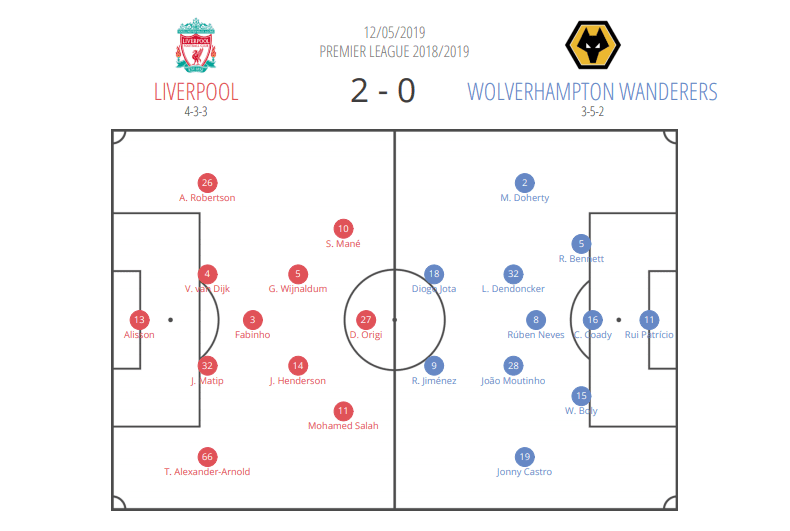
With everything still to play for, Jürgen Klopp needed to pick his strongest team possible if he wanted to beat a stubborn Wolves. Firmino’s injury meant he was still unavailable, but Salah was ready to return to the lineup after receiving a head injury against Newcastle. After an impressive win against Barcelona, Klopp understandably didn’t want to change much, but that didn’t stop him from making changes. Shaqiri was dropped in favour of a fit Salah, while Georginio Wijnaldum came back into the midfield ahead of James Milner.
Nuno Santo didn’t make any changes after his team’s win over Fulham. The team lined up in a 3-5-2 formation, with Matt Doherty and Jonny playing as attacking wingbacks.
How it happened
Liverpool started off the match well, grabbing themselves a goal through Sadio Mané in the 17th minute. Anfield erupted, and things only improved for Liverpool after the news of Glenn Murray’s goals against Manchester City circulated through the stadium.
But Wolves responded well, threatening Liverpool through Matt Doherty on the right side of midfield. Alas, Wolves couldn’t equalize and Liverpool doubled their lead in the 81st minute from a Sadio Mané header.
But the win wasn’t enough, as Pep Guardiola and Manchester City put four goals past Brighton to win the league. The game was won by Liverpool, but the Premier League was lost. The rest of this tactical analysis will analyze the key moments of this match.
Matt Doherty
Wolves best chances came from their right midfielder Matt Doherty. The Irishman was a constant threat for Wolves, dribbling into dangerous areas behind Liverpool’s back line. His presence high up the field caused problems for Andrew Robertson.
As well as providing defensive cover for his team, Doherty attempted to overload the right side Liverpool’s defensive third. His attacking threats came from dribbles into the area, overlapping runs and crosses into the box. Let’s take a look at some examples.
In the following sequence, Matt Doherty wins the ball high up the field and explodes into space. As he does, his teammates react to the transition and make runs into the box. The runs of Diogo Jota and Raúl Jiménez occupy Liverpool’s defenders while Moutinho waits on the top of the box. Doherty splits Fabinho and Robertson to find the midfielder but Jordan Henderson steps in to intercept the pass.
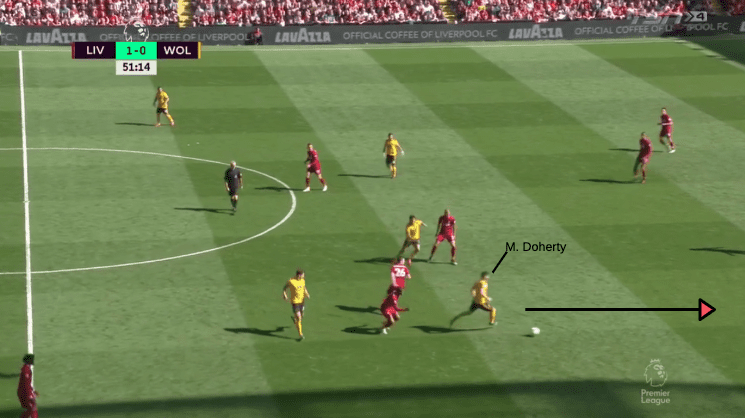
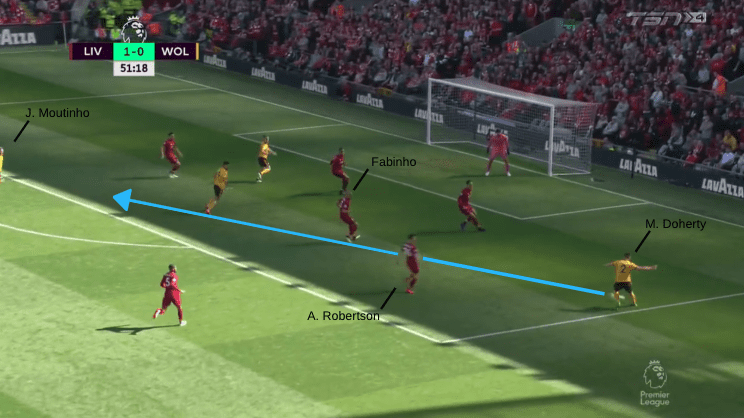
Doherty was able to attack these spaces and play balls into the box. Unfortunately for Doherty and Wolves, his teammates rarely got on the end of his passes or crosses. This was a result of Liverpool’s defensive positioning.
In the 64th minute, Doherty finds his target. The Irishman attacks the free space as Leander Dendoncker makes a run to the near post. Dendoncker’s run into the box pulls in Van Dijk and Milner. As Dendoncker receives the pass, Robertson steps away from Doherty. Dendoncker plays the ball back to a free Doherty, and while this is happening, Jiménez runs into the free space between Matip and Van Dijk. Doherty plays the ball to Jiménez on his first touch, but the Mexican striker couldn’t hit the target.
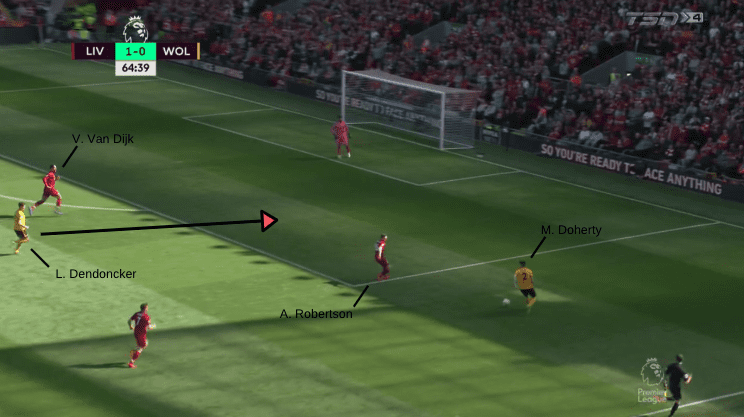
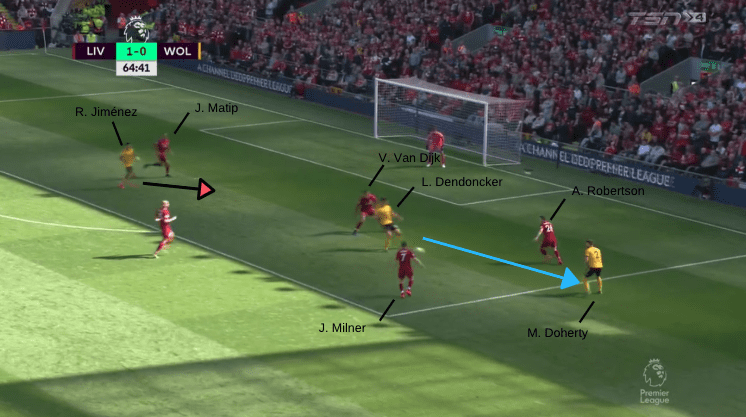
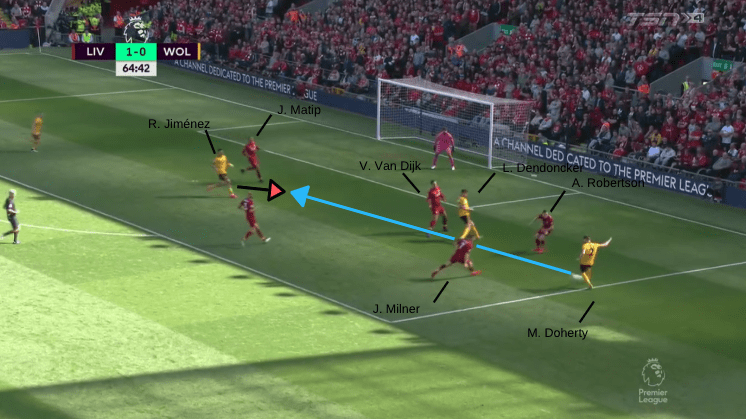
Doherty found himself in dangerous positions on countless occasions. The buildup play down the right side in the previous sequence showcased the potential for Wolves to score. Liverpool’s defensive shape in the middle of the park is what forced Wolves to play out wide, but it also meant that finding a target in the box was difficult. With two shots on target all game, and four shots off target inside the box, Wolves will regret not being more clinical with the chances they had.
Wolves direct ball
Liverpool’s high press makes it very difficult to play out of the back and through the midfield. Wolves were able to bypass this on many occasions by hitting their target players from deep areas. The direct ball offered an outlet for Nuno Santo’s defenders, allowing his attacking players to start the attack high up the field.
Many times Wolves looked to bypass Liverpool by playing a direct ball to their strikers. Wolves played long balls into the mid or final third 15 percent of the time they passed. Nuno Santo’s team used this tactic to start their attack up high up the field, avoiding the solidity of Liverpool’s midfield trio.
Wolves mainly tried to play the long ball to the left side of the field, avoiding Virgil Van Dijk. On many occasions, this meant switching the play from the right side of the field to the left.
In the following sequence, we can see Ruben Neves play a direct ball played into Jota. The striker holds up the ball well before laying it off to Jonny. As the transition is happening, Dendoncker runs into the free space between Liverpool’s centre backs. Jota then overlaps the fullback and plays a cross into Dendoncker. Joel Matip steps in to prevent the shot.
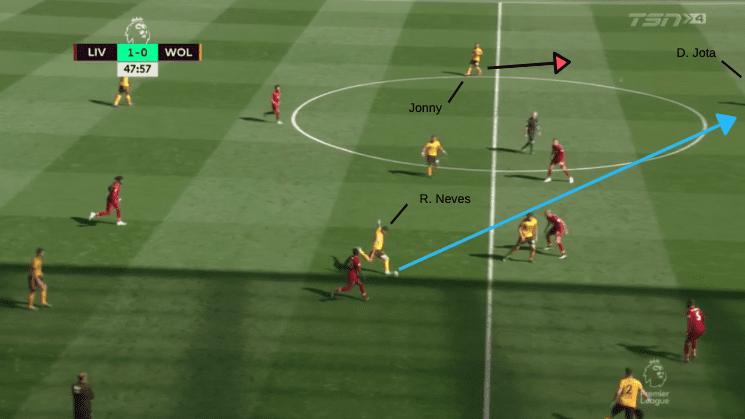
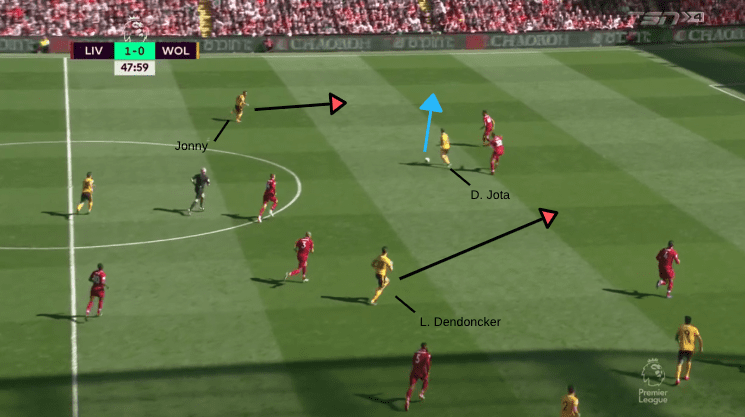
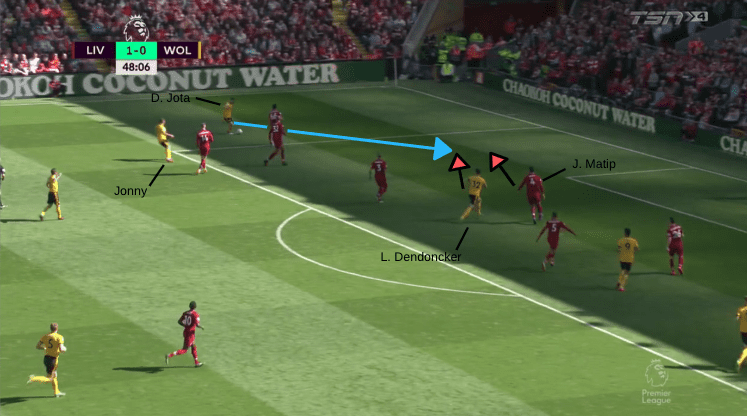
This passage of play highlights Wolves’ ability to hit their target man from deep and win start an attacking movement high up the field. As the ball from Neves came into Jota, both Jonny and Dendoncker reacted to the offensive transition up the field. The transition allowed Wolves to attackers to exploit the free space on the left side of the field.
Another one of Wolves’ best chances came from Doherty, but not down the right side of the field. The Irishman spotted the runs of Jota and Jiménez on the far side of the field. The ball finds his target and Jota had a great chance to equalize the game. Alisson made a great save to deny the Portuguese striker.
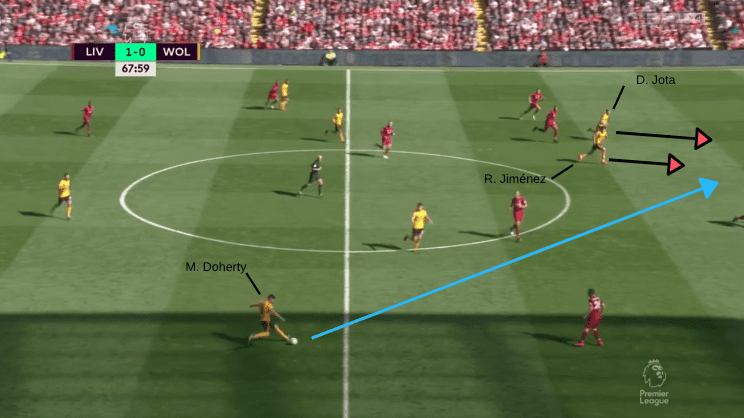
This tactic was also used to release Doherty into space on the transition. Rarely did Wolves look to play through the middle. The biggest factor in Wolves’ success on the ball was being able to release the ball to players in isolation quickly.
The difference maker
At the end of the day, the difference for Liverpool was quality in the final third. Alexander-Arnold was brilliant on the day, playing dangerous balls into the box for his teammates. Both goals were a direct result of the English fullback’s passing quality. Alexander-Arnold attempted 96 passes throughout the match.
Andy Robertson, while occupied with Matt Doherty, was also able to play quality balls into the box during the match. Notably, Robertson played a dangerous ball back post for Georginio Wijnaldum in the second half. Liverpool’s reliance on their fullbacks is no tactical surprise. Robertson and Alexander-Arnold have been vital throughout the course of Liverpool’s season.
Wolves, while also able to occupy space in dangerous areas, were unable to capitalize on their chances. The quality of passes into the box was inconsistent and any chances they had were wasted. Robertson had an 81 percent pass success rate and Alexander-Arnold was successful 77 percent of the time. In contrast, Doherty’s pass success rate was 53 percent.
Conclusion
Although they made life difficult for Liverpool, Wolves couldn’t quite convert in the final third. Jürgen Klopp’s team once again did just enough to earn three points, but it wasn’t enough to win the title. Both teams can hold their head up high though. A record Premier League points tally for Liverpool is impressive enough, and Nuno Santo has led his newly promoted Wolves to seventh place with outstanding football.
Wolves will look to continue their form next season, while Liverpool shift their attention to Madrid where they face Mauricio Pochettino and Spurs in the UEFA Champions League Final.
If you love tactical analysis, then you’ll love the digital magazines from totalfootballanalysis.com – a guaranteed 100+ pages of pure tactical analysis covering topics from the Premier League, Serie A, La Liga, Bundesliga and many, many more. Buy your copy of the May issue for just ₤4.99 here, or even better sign up for a ₤50 annual membership (12 monthly issues plus the annual review) right here.

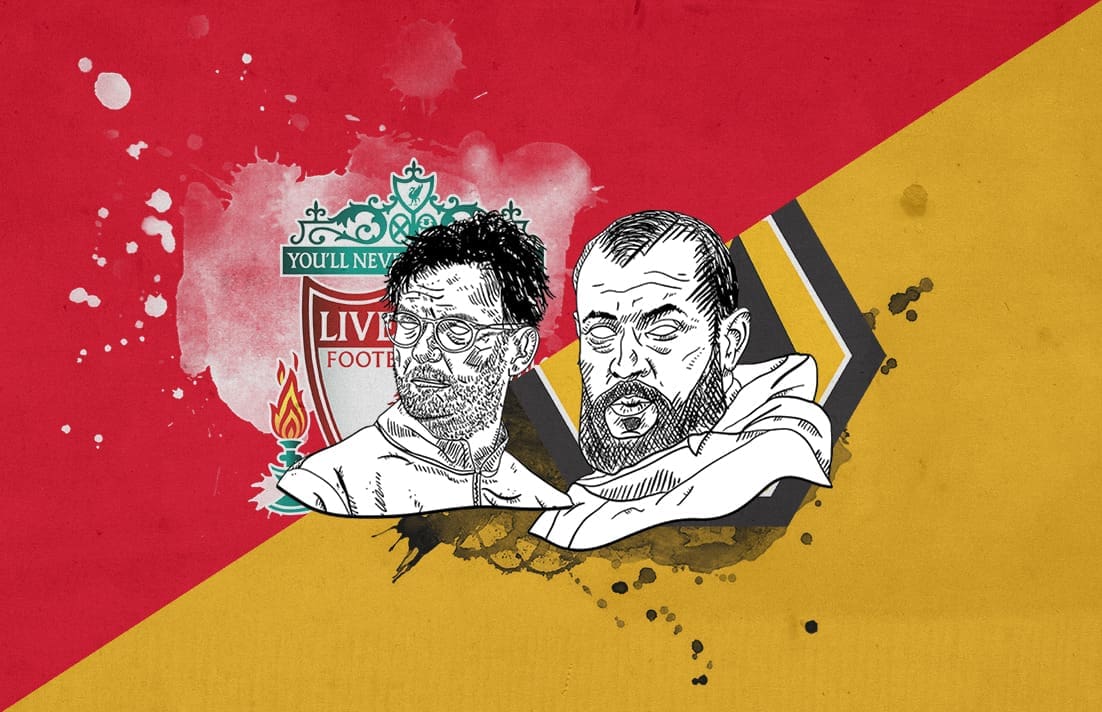



Comments